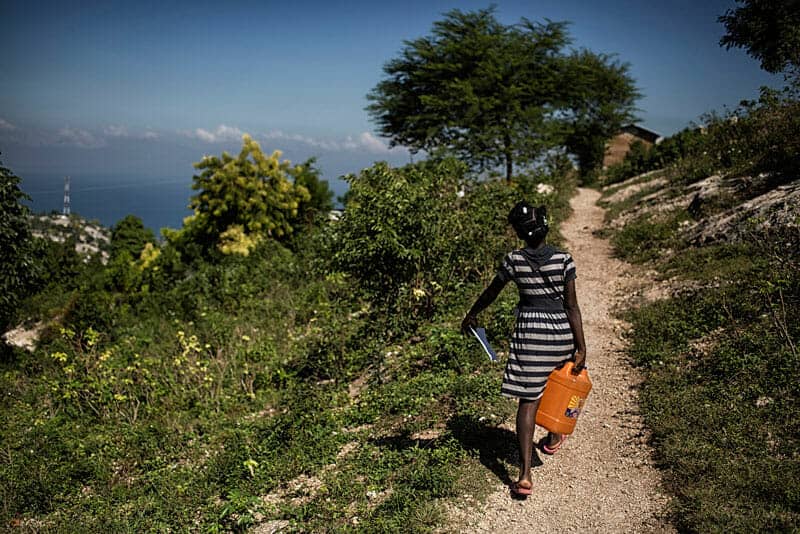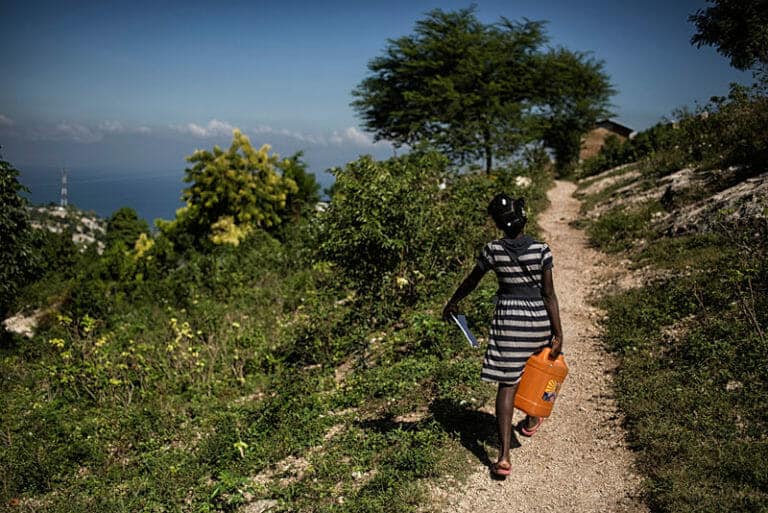Photo: © Caritas Internationalis.
Justice for women in the access to water and sanitation will not be attained without more specific statistical data on their situation. The campaign #NoWalking4Water needs to raise our awareness of the gender invisibility suffered by millions of women, which prevents efficient actions from being carried out in order to achieve the Sustainable Development Goals.
The water crisis affects women twice over. In the poorest areas, where water cannot be found, women and girls are the ones in charge of collecting it, while men take over other tasks in the fields. The direct consequences of this situation are linked to the images of women and girls carrying heavy water drums, walking under a scorching sun: extreme hardship, insecurity, social disruption and school absenteeism. When it comes to sanitation, the picture is not encouraging either: the indignity of open defecation at night, the vulnerability to sexual assaults and the lack of privacy in menstrual periods are the best-known consequences.
But there is another serious problem for these women: the absence of specific data on their situation. This lack of information is an important hindrance to develop situations that end this scourge. Gender-disaggregated data are needed, as they are essential to develop the human geography in connection with water and sanitation, thus obtaining scientific evidence on gender inequalities. This evidence is necessary to find out what happens in reality and to have a reliable starting point to develop efficient policies.
We know that 11% of the world population lacks access to a water source.
According to a 2013 survey by the United Nations Statistical Commission, the gender-disaggregated data (men/women) on access to water and sanitation are one of the most deficient indicators at national level. 45.2% of all countries worldwide do not develop statistics related to water resources that include this gender perspective. Regarding sanitation, the percentage of those that do have gender-disaggregated statistics only reaches 39%, while the access to water bears the brunt, with only 37% of the countries offering data to international organizations that take into account the female reality. These are mainly developing countries and they are located in areas with the highest hydric stress in the world.
Qualitative data instead of purely quantitative data are needed
We know that 11% of the world population lacks access to a water source. UN Water defines this as the access to a source that supplies at least 20 litres per day and person, located within a distance of 1 km from the house. These parameters, along with the general estimates of the role of women in certain areas around the world, have enabled the extrapolation of the terrible figures we handle today, which indicate, for instance, that the average distance travelled by African or Asian women to collect water is 6 km, and that the average weight of the water they carry on their heads is 20 kg.
We also know that in the African Sahel, women and girls walk on average six kilometres every day to carry home a few litres of water; we also know that in Senegal, Mozambique or Uganda women are forced to walk ten kilometres on average to collect water every day. It is estimated that in the African continent, the time spent by women and girls in the collection of water exceeds 40 billion hours every year.
But these data alone are inoperative. They are useful to […]
Full article: Water and women: we need to know more
More about women and water around the world:
Women’s Day: Access to water crucial to emancipating women – AWWASHNet
The women fighting a pipeline that could destroy precious wildlife



